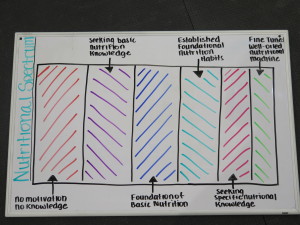As you may have heard, I made a change in my nutrition towards the end of last year. The physical results were immediately apparent: lower body fat, improved overall strength/fitness, and increased muscle. However, I think the most important part of this process was the knowledge I gained. Here are some tips I learned along the way.
Long-Term Goal: Find what works for you.
 We say it a lot: you have to find out what works for you. We are all individuals, and unfortunately there is no one size fits all solution. The problem I found, most people don’t know where to start to find out what works for them. So let’s start on Step 1…
We say it a lot: you have to find out what works for you. We are all individuals, and unfortunately there is no one size fits all solution. The problem I found, most people don’t know where to start to find out what works for them. So let’s start on Step 1…
Step 1: Establish your goals, and understand what it takes to get there.
Before you start anything, ask yourself “what does success look like?” This doesn’t have to be a concrete goal, but you have to start somewhere. This goal should be a guide and I encourage you to check in from time to time and adjust as needed. Do you want six pack abs, are you trying to drop your mile time, improve bodyweight movements, get stronger, etc… It’s totally okay to say all of the above!
The next part gets tricky. You may not know the details just yet, but you have to understand the effort it’s going to take to get there. Are you trying to lose 2-4% bodyfat, or 20+%? Do you want to drop 10 seconds from your mile, or 3 minutes? You see where I’m going here? Don’t be afraid to have big goals, but understand that BIG GOALS TAKE BIG WORK.
Step 2: Ask yourself, why are you doing this?
If you don’t have a reason, you’re much more likely to give up. And that WHY is completely up to you. This doesn’t have to be a righteous, above everyone else ‘why’. It just has to be important to you. Are you trying to get fit so you look awesome at the beach? If that’s a big enough driver for you, then go with it! Whatever the reason – as long as it matters to you – hold onto this and you will find success. When you’re struggling to do what you need to do, think back to that ‘WHY’.
Step 3: Be fearless with your quest for improvement.
To really make a change, you have to be ready to get uncomfortable. The bigger the change, the more uncomfortable you’ll get. You can’t let preconceived notions, self-doubt, or negativity hold you back. “Whether you think you can, or you think you can’t, you’re right” (Henry Ford). You may not be at your goal now, but that doesn’t mean you won’t get there.
Don’t be afraid to throw out everything you thought you knew.
Don’t be afraid to start it all over again! We’re constantly learning, and if you stay stagnant, you’re missing out.
Keep an open mind and make the best decisions you can with your current knowledge. I always go back to, “if everything we ‘knew’ wasn’t working, maybe it’s time to try the opposite.”
Step 4: Be honest with yourself.
That doesn’t mean be mean to yourself. Throughout the process, you have to be realistic. That means, don’t be afraid to step on the scale and don’t avoid the doctor because they might have bad news. YOUR BODY IS AN AMAZING THING.
Once you know what you want to fix, you work towards that fix, and most of the time, your body adjusts. This is really apparent when someone has a lot of weight/body fat to lose. They resign to the fact that getting to a truly healthy weight is impossible, and they settle for good enough. While I agree that improvements are a step in the right direction, don’t short change yourself with doubt. Just be honest, move on, and CRUSH YOUR GOALS!
Step 5: Be accurate and accountable.
To make an improvement, you need to establish a start and a finish line. You also need to know how you will measure success. The more accurate you are, the easier it will be to make adjustments to your plan.
Along with accuracy, you have to be accountable. Understand that CONSISTENCY IS MORE IMPORTANT THAN PERFECTION and there will be bumps in the road. You don’t have to give yourself a free pass, but you have to own it. You established your goals and you know what it takes to get there – so don’t beat yourself up for missing a training session, or eating a pint of ice cream. You knew it would happen, and you knew that it was your decision to eat that pint of ice cream. Own it, and move on.
Why Nutrition?
 IF you’re asking, why do I need to focus on nutrition if I want to run faster or lift more weights? On the surface, it makes sense to do more of what you’re trying to get better at. If I want to run faster, I should practice running. If I want to lift heavier, I need to put in more work at the gym.
IF you’re asking, why do I need to focus on nutrition if I want to run faster or lift more weights? On the surface, it makes sense to do more of what you’re trying to get better at. If I want to run faster, I should practice running. If I want to lift heavier, I need to put in more work at the gym.
I wish it were that easy.
The work you put in at the gym is the easy part. I’ll say that again, what you do in the gym is one of the easiest pieces to your success puzzle – the tip of the iceberg. AT THE BASE OF EVERYTHING WE DO IN THE GYM IS NUTRITION.
Using me as an example, I changed absolutely nothing I did in the gym. Only my eating habits were modified, and suddenly I saw improvements in my lifting. At the same time, my body fat started dropping and I got faster. With my newfound energy, I was able to work harder in the gym, and it took less perceived effort from my body. The common thought that working hard in the gym outweighs working SMARTER to see physical results is wrong. Working hard in the kitchen first will allow your body to work hard in the gym.
Coach Pat
